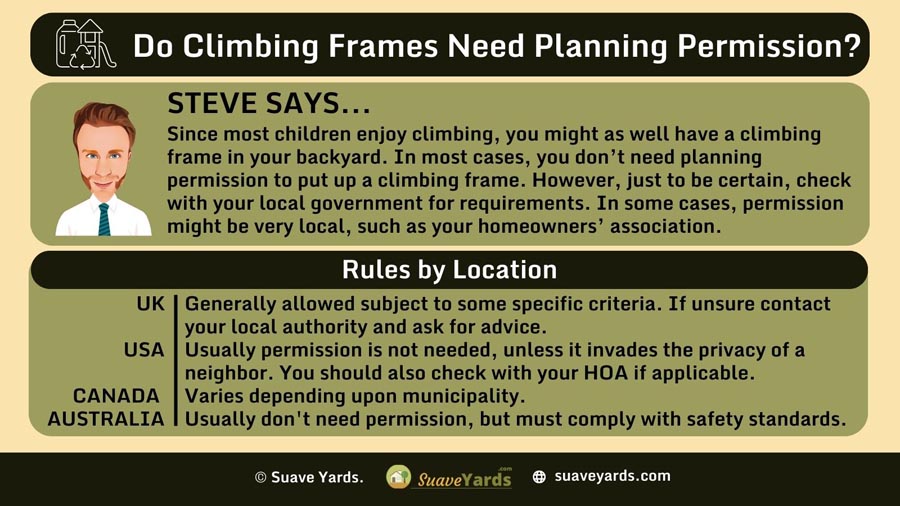
So, you figured that a climbing frame would be good for your children.
It’s a great way for children to exercise while also having loads of fun.
But do you need to ask planning permission for such a structure?
Let’s find out…
Since most children enjoy climbing, you might as well have a climbing frame in your backyard. In most cases, you don’t need planning permission to put up a climbing frame. However, just to be certain, check with your local government for requirements. In some cases, permission might be very local, such as your homeowners’ association.
What Is a Climbing Frame?
Cambridge Dictionary defines the climbing frame as “a large frame made of bars that children can climb on.”
Research suggests that the first climbing frame was invented in Germany in the late 1800s.
However, people have to go by what’s on the record.
Official records say Sebastian Hinton invented the climbing frame, which he called a jungle gym, in 1920.
It is based on the patent he applied for and was granted in 1923.
The climbing frame is a term often used in Europe.
It has since evolved from the simple climbing structure of the 1900s that consists of bars where children can climb on and swing from one rod to the other.
The climbing frame is a great way for children to have fun in the form of exercise.
Why Children Climb

It is innate in children to enjoy climbing, especially when they discover that they can.
That’s why you often see toddlers climbing up the couch, bookcase, and other pieces of furniture.
According to this VeryWellFamily article:
“Short of removing from your home every vertical object as well as objects that could be stacked vertically, you can’t really stop a climber. And really, you don’t want to (at least not in the long run).”
Maureen Ryan
Allow your child to climb because it is an important part of the development of gross motor skills.
But as parents or guardians, the main concern is always safety.
Here’s a suggestion: build a climbing frame in your yard!
Or you may buy them too.
A climbing frame gives children the outlet to be active.
And since many of them want to climb, you can at least give them a safe structure that is meant for children to climb on.
Just make sure your ground is safe for landing in case they fall or they purposely jump down.
Check out our recommendation of five materials you can use within your landing zone.
Now, the issue is whether you need a planning permit to put up a climbing frame in your backyard.
What are the rules?
Should You Apply for Planning Permission to Put Up a Climbing Frame?
First, what is planning permission?
It is a form of request you submit to a local authority over proposed building work.
You cannot start building unless the authority approves or gives you a permit.
The point of the planning permission is to prevent people from building structures that are not suitable or inappropriate for the environment.
For example, when you build a house, you need to get a permit to do so.
Even renovations or improvements to an already-approved home need a planning permit.
The specific details of the planning permission differ from one place to another.
In one place, you may need a permit to put up a climbing frame but it may not be necessary in another area.
Let’s check out planning permissions in four countries:
United Kingdom

In the U.K., an outbuilding is generally allowed subject to some specific criteria.
An outbuilding is defined as a small building, such as a shed, garage, or barn, that stands on the same property as the house but is detached.
While a climbing frame is not necessarily an outbuilding, when it comes to planning permissions, the rules are similar.
Generally, there is no need for a permit to build an outhouse or climbing frame.
But a climbing frame or playhouse must meet the following standards:
- If the structure is within two meters from the boundary, it can be a maximum of 4 meters high with a ridged roof.
- If the structure has a flat roof, it can be 3 meters high when built within 2 meters of the boundary.
- The climbing frame must not be between the house and the main highway.
- For climbing frames with an attached playhouse, the floor area must not be more than 30 square meters.
- If a platform is part of the climbing frame, it must not exceed 30 centimeters (11.8 inches)
- The structure must not cover more than half the land surrounding the house.
The above-mentioned criteria may change when you live in a Conservation Area.
The best thing to do is to contact your local authorities and ask for the community rules for building a climbing frame.
United States
Some may think it’s complicated in the U.S. since there are federal laws, state laws, and county measures.
But when it comes to climbing frames, it’s more about the neighborhood.
Generally, most climbing frames should be okay unless a neighbor or two would complain.
One of the most common complaints, which is warranted, is the lack of privacy.
So, if your climbing frame (or jungle gym as it is commonly called in the U.S.) is tall enough that children could have a peek at the neighbor’s house, then you may need planning permission.
Get permission from the homeowners’ association, in this case.
The permit may come with conditions that would protect a neighbor’s privacy.
Some neighborhoods may also be against a climbing frame that may be considered an eyesore within the community.
To sum it up, planning permission is not necessary in the U.S. but a few neighbors may find a climbing frame objectionable.
If you live in a child-friendly community, then you may not have anything to worry about.
In a more upscale and less child-friendly neighborhood, you may need to get verbal permission from neighbors.
Canada
In Canada, planning permission depends on the municipality.
Contact authorities and check restrictions on climbing frames and other play structures.
Some areas may also have requirements on ground cover for safety.
Australia
In Australia, play equipment like the climbing frame doesn’t need a building permit or planning permission.
But structures for children have to comply with Australian standards, which usually pertain to requirements for the following:
- Free height of fall – this refers to the distance between the highest point of the structure where the child may fall and the ground.
- Fall zone – this pertains to the area where a child could possibly fall from playing in the climbing frame. The area should be free from any hard surface.
- Impact absorbing surface – the fall zone must be covered with materials that absorb the impact from a fall.
Standards are not mandates though.
They are guides to ensure that the play area is safe for your children.
You don’t need planning permission to put up a climbing frame in Australia but it’s ideal to follow the country’s standards.
Final Thoughts

Climbing frames are great for children’s development.
If you have enough money, it is a type of play equipment worth investing in for your yard.
Most countries don’t have national laws on building or setting up climbing frames.
However, some homeowners associations and local authorities may have their own rules regarding additional structures at home.
Some concerns are on privacy while others are more on aesthetics.
Check with your homeowners’ association to see if there are guidelines on climbing frames and play structures.
